Lugares de interés (POIs) del Mapa
0: Muxe or Muxhe (Zapotec of Oaxaca)
Among the Zapotec of the Oaxacan peninsula, the muxe aregenerally males who either dress as women or dress as males with make-up. Theymay adopt “feminine” social roles such as working in embroidery, but many alsohave white-collar careers in Mexico. In recent decades, the term has also come to applyto gay men.

Más sobre Muxe or Muxhe (Zapotec of Oaxaca)
1: Nadleehi and Dilbaa (Navajo)
The Navajo term nadleehi refers to that culture's traditional third gender, in which a biologically male-born person embodies both the masculine and feminine spirit. Dilbaa refers to a female-born person with a more masculine spirit. Both are considered to encompass both genders in one person.
Fred Martinez, the subject of the documentary Two Spirits, was nadleehi. Navajo tradition places nadleehi and dilbaa in high esteem and they often assume roles as healers in their tribes.
Más sobre Nadleehi and Dilbaa (Navajo)
2: Winkte (Lakota)
Winkte is the Lakota word for two-spirit people.::text Like the Navajo nadleehi and dilbaa, the winkte are born male but assume many traditional women's roles, such as cooking and caring for children, as well as assuming key roles in rituals and serving as the keeper of the tribe's oral traditions.
Más sobre Winkte (Lakota)
3: Kathoey (Thailand)
Very loosely translated as "ladyboys," Thailand's third gender kathoeys are known as being born male but "having a female heart," according to a common Thai saying. They are often referred to as "sago," or a second type of woman.
The kathoey culture is extremely broad, encompassing drag queens and other cross-dressers (straight and gay), to effeminate gay males, on one end, and post-operative transsexuals on the other. Kathoeys generally work in service jobs as in beauty salons and restaurants, but can be found in all professions at all levels of society. Some end up as sex workers catering mainly to tourists.
Thai tradition holds that true kathoeys are neither male nor female but inhabit the space between genders.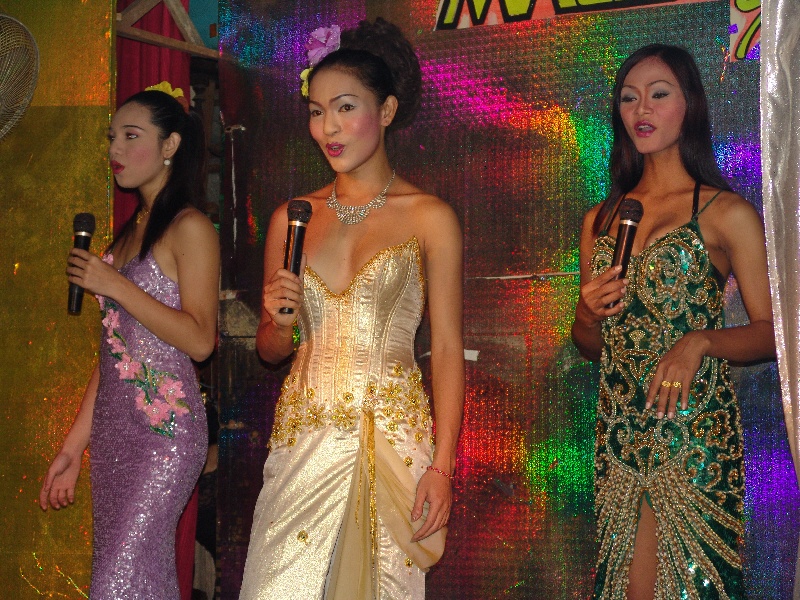
Más sobre Kathoey (Thailand)
4: Fa'afafine (Samoa)
Fa'afafine are not considered "gay" in Samoan culture, as they may be sexually involved with men, women, or other fa'afafine.

Más sobre Fa'afafine (Samoa)
5: Calabai, Calalai, and Bissu (Indonesia)
The Bugi people of southern Sulawesi recognize three sexes (male, female, intersex) and five genders: men, women, calabai, calalai, and bissu. Calabai are biological males who embody a feminine gender identity. Calalai are biological females who embody a male gender identity. Bissu are considered a "transcendent gender," either encompassing all genders or none at all. The bissu serve ritual roles in Bugi culture and are sometimes equated with priests.
Más sobre Calabai, Calalai, and Bissu (Indonesia)
6: Waria (Indonesia)
Waria are often falsely lumped into a stereotype as flamboyant cross-dressing sex workers, when a majority do not fit that description.

Más sobre Waria (Indonesia)
7: Fakaleiti (Tonga)
Similar to the third gender traditions in Samoa and Hawaii, the Tongan fakaleiti a biological males who adopt feminine dress, mannerisms, and social roles. They do not necessarily consider themselves to be transgender or gay, which are considered strictly Euro-American constructs that do not apply.
Más sobre Fakaleiti (Tonga)
8: Mahu (Hawaii)
Long before Cook's arrival in Hawaii, a multiple gender tradition existed among the Kanaka Maoli indigenous society. The mahu could be biological males or females inhabiting a gender role somewhere between or encompassing both the masculine and feminine. Their social role is sacred as educators and promulgators of ancient traditions and rituals. The arrival of Europeans and the colonization of Hawaii nearly eliminated the native culture, and today mahu face discrimination in a culture dominated by white European ideology about gender.
Más sobre Mahu (Hawaii)
9: Chuckchi (Siberia)
The Chuckchi (and neighboring indigenous peoples including the Koryak, and the Kamchadal) are a nomadic, shamanic people who embrace a third gender. Generally shamans are biologically male with some adoption of female roles and appearance, who married men but also were not subject to the social limitations placed on women. Third gender Chuckchi could accompany men on the hunt, as well as take care of family.
Más sobre Chuckchi (Siberia)
10: Ninauposkitzipxpe (Blackfoot)
The ninauposkitzipxpe were honored as a third gender in the North Peigan tribe of the Blackfoot Confederacy in northern Montana and Southern Alberta, Canada. Roughly translated, it means "manly-hearted woman," and defined a biological female who did not necessarily dress in a masculine mode, but was unrestricted by the social constraints placed on other women in the Blackfoot society.
Más sobre Ninauposkitzipxpe (Blackfoot)
11: Burrnesha (Albania)
First documented in the 1800s but traced back to the 1400s, Northern Albania's burrnesha ("sworn virgins") are biological women who a take a vow of chastity and wear male clothing in order to be viewed as men in the highly patriarchal society. The tradition exists to a smaller extent in Kosovo, Serbia, and Montenegro. The tradition is dying out: There are believe to be fewer than 50 sworn virgins left in the Balkans.
Más sobre Burrnesha (Albania)
12: Femminiello (Italy)
Femminiello (roughly "little man-woman") refers to biological males who dress as women and assume female gender roles in Neopolitan society. Their station in society is (or was up through the 19th century) privileged, and the rituals (including marriage to one another) was based on Greek mythology related to Hermaphroditus and Teresias (who was transformed into a woman for seven years).
Más sobre Femminiello (Italy)
13: Ashtime (Maale, Ethiopia)
Historically among the Maale people of southern Ethiopia, the word ashtime referred to eunuchs who lived in the home of the most powerful spiritual or political leader, because biological women were forbidden to enter. These ashtime enjoyed privileges in return for maintaining the homestead and performing other woman-associated duties.
More recently, anthropologists have discovered that the meaning of the term has broadened to include any gender non-conforming male, including unmarried or disabled men who cannot carry out traditional male roles. This morphing of meaning seems to date from the arrival of Protestant missionaries in the 1970s.
Más sobre Ashtime (Maale, Ethiopia)
14: Whakawahine (Maori, New Zealand)
In Maori culture, wakawahine are men who prefer the company of women and take up traiditionally feminine occupations such as weaving. Wakatane denotes a biological female who pursues traditionally male roles, such as becoming a warrior or engaging in physical labor. 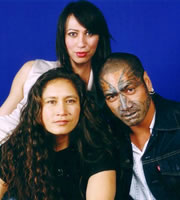
Más sobre Whakawahine (Maori, New Zealand)
15: Quariwarmi (Inca, Peru)
In pre-colonial Andean culture, the Incas worshipped the chuqui chinchay, a dual-gendered god. Third-gender ritualattendants or shamans performed sacred rituals to honor this god. The quariwarmi shamans wore androgynous clothing as "a visible sign of a third space thatnegotiated between the masculine and the feminine, the present and thepast, the living and the dead. Their shamanic presence invoked theandrogynous creative force often represented in Andean mythology," according to scholar Michael J. Horswell.
They were deemed sodomites by the conquering Spaniards.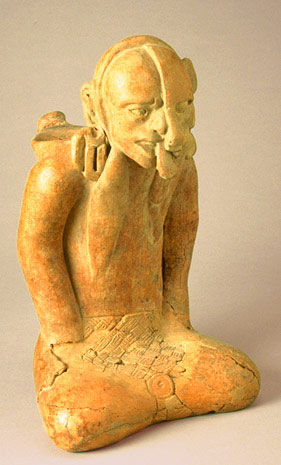
Más sobre Quariwarmi (Inca, Peru)
16: Mashoga (Kenya, Tanzania)

Más sobre Mashoga (Kenya, Tanzania)
17: Hijra (South Asia)
In South Asian cultures including India, Pakistan, and Bangladesh, hijras are physiological males who adopt feminine gender identity, women's clothing and other feminine gender roles. In the past the term referred to eunuchs or those born intersex or with indeterminate genitalia.
Most hijra do not consider themselves to be men or women or transgender, but a distinct third gender. A tradition of castration still exists but is no longer requisite to be recognized as a hijra.
Hijra generally live on the margins of society and many are forced to survive by begging or sex work. In India per Hindu mythology, hijras represent thehalf-male, half-female image of Shiva — an image symbolic of a being thatis ageless and sexless.
Hijras have a long recorded history in the Indian subcontinent, from the Mughal Empire period onwards. Many hijras live in well-defined, organized, all-hijra communities, led by a guru. (The word hijra is originally from Urdu, but has been adopted into Hindi. In Urdu, it is considered an epithet, and the term Khwaja Saraa is used instead).
During the era of the British Raj, authorities attempted to eradicate hijras, whom they saw as "a breach of public decency." Also during British rule in India they were placed under the Criminal Tribes Act1871 and labelled a "criminal tribe," hence subjected to compulsoryregistration, strict monitoring and stigmatized for a long time, afterindependence however they were decriminalized in 1952, though the stigma continues.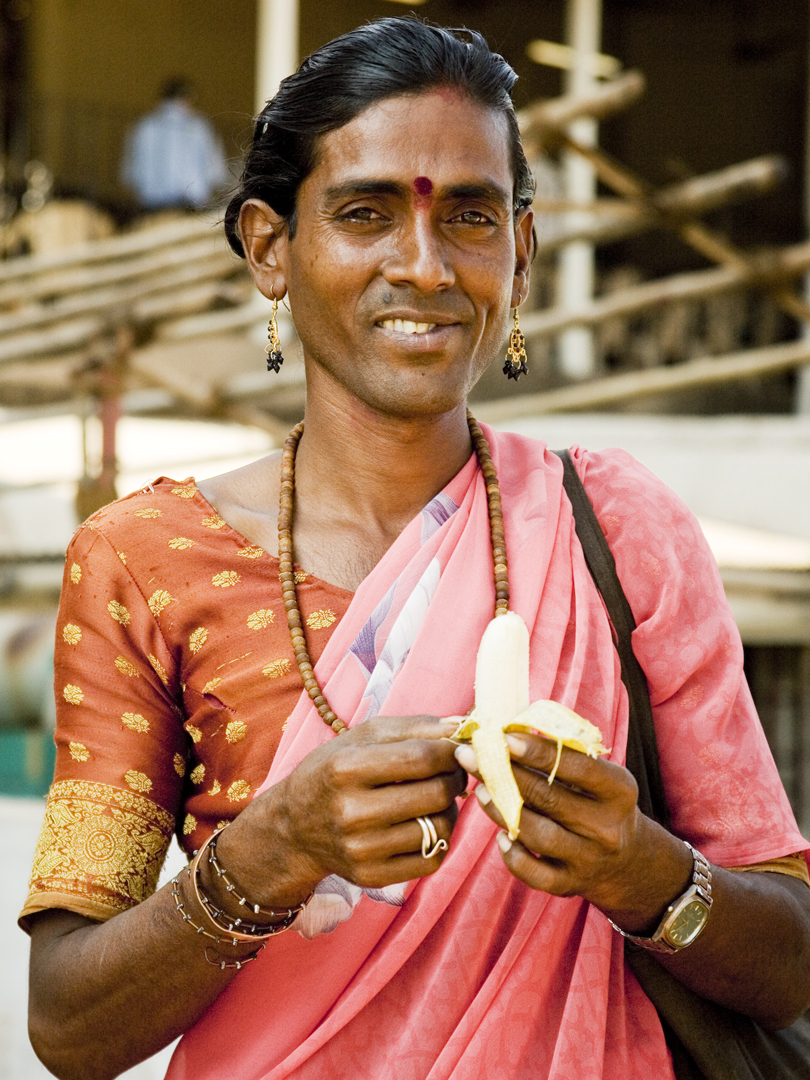
Más sobre Hijra (South Asia)
18: Aravani (Tamil Nadu)
A subset of the hijra tradition are the aravanis, who are born male but adopt female gender roles early in development. They take their name from the mythical deity Aravan (the brides of Aravan).
In the ancient sanskrit epic Mahabharata, the Pandavas could conquer Kurukshetra if theysacrificed a ‘perfect’ male from among themselves. Aravan, the virginson of Pandav prince Arjuna, offered himself up for sacrifice. But hehad a request: that he be allowed to spend one night as a married man.
No king was willing to give his daughter in marriage only to have her widowed the next day, so finally, Lord Krishna assumed female form andmarried Aravan, and after a night of sexual bliss, Aravan was beheaded.
Every year, during the first full moon of the Tamil month of Chittirai(April- May) aravanis converge at Koovagam to commemorate this ancient narrative. They identify themselves with the female form Krishna assumed for his night with Aravan.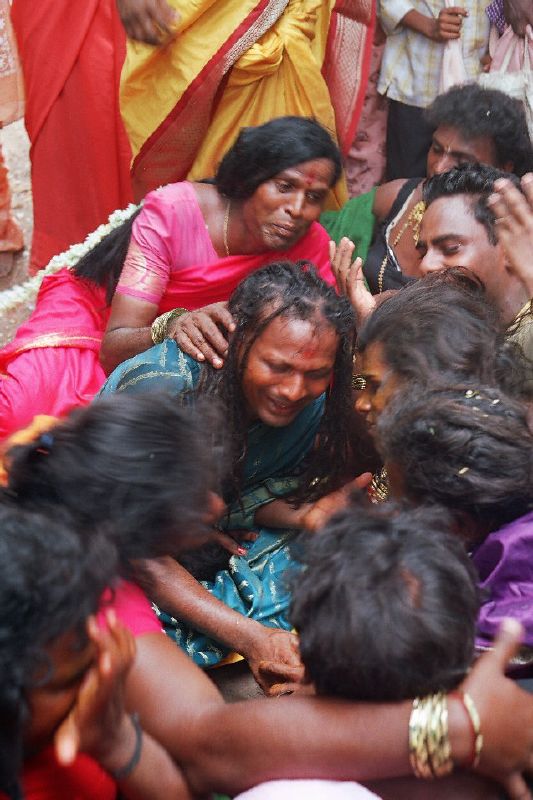
Más sobre Aravani (Tamil Nadu)
19: Alyha and Hwame (Mohave)
The creation myth of the Mohave tribe speaks to a time when humans were not sexually or gender-differentiated. The recognize four genders: men, women, hwame (male-identified females) and alyha (female-identified males).
Más sobre Alyha and Hwame (Mohave)
20: Lhamana (Zuni)
The two-spirit Zuni tradition is known as lhamana, in which a person lives as both genders simultaneously. They play a key role in society as mediators, priests, and artists, and perform both traditional women's work (pottery and crafts) as well as traditional men's work (hunting).
The most famous example was We'wha, a biological man who served as the Zuni ambassador to the United States, who spent six months in Washington, D.C. where she was feted enthusiastically by the establishment who probably had no idea she wasn't born female. 
Más sobre Lhamana (Zuni)
21: Guevedoche (Dominican Republic)
In an exceptional case, genetics seems to have created a third sex in Dominican Republic. A heritable pseudo-hermaphroditic trait was discovered by ethnographers in the 1970s, who followed the children over generations. With undifferentiated genitalia, they generally were raised as girls, but began developing male traits at puberty. Instead of changing their gender identities to male, most chose to live as a third gender called guevedoche (roughly meaning "testicles at 12") or machi-embra (man-woman). The society has accommodated the guevedoche and constructed a third gender with distinct roles for them.
Más sobre Guevedoche (Dominican Republic)
22: Bakla (Philippines)
Bakla is a Tagalog term that encompasses an array of sexual and gender identities, but especially indicated a male-born person who assumes the dress, mannerisms, and social roles of a woman. While bakla have existed as a recognized third gender for centuries, more conservative influences in recent decades has marginalized them.
The bakla actually developed their own language to use with each other, called swardspeak. It is a mixture of Filipino, English and Spanish and is spoken with a "hyperfeminized inflection."
Más sobre Bakla (Philippines)
23: Xanith (Oman)
The xanith of Oman are considered an intermediate gender in this Islamic nation. They are biological males and do not practice emasculation, but do assume the dress, mannerisms, and some social roles of women.
However, "they have masculine names and are referred to in the masculine grammatical gender form. Under Islamic law they have all the rights of a man, for example, the right to testify in court, a right that is denied to women. They also worship in the mosque with men." They are also permitted, unlike women, to hold paying jobs.
Más sobre Xanith (Oman)
24: köçek (Ottoman Empire)

Más sobre köçek (Ottoman Empire)
25: Transsexuality in Iran
Transsexual rights are actually acknowledged in Iran, where it is still punishable by death to be gay. Due to a decree by the Ayatollah Khomeini, gay and/or transgender men are permitted to live lives as straight women and permitted to undergo sex reassignment surgery, after which their official documents are changed to reflect their new identities.
Más sobre Transsexuality in Iran
26: Travesti (South America)
Travestis' feminine identity includes feminine dress, language, and social and sexual roles. However, in contrast to transsexual women, they often don't see themselves as women, and many describe themselves as gay or homosexual. Travestis may modify their bodies with hormones or silicone, but rarely seek genital surgery.
Many travestis survive through prostitution. In recent years, violence against travestis has skyrocketed, especially in Brazil.

Más sobre Travesti (South America)
27: Skoptsy (Russia)
The Skoptsy were a Christian religious sect with extreme views on sex and gender. The community, discovered in 1771 in Western Russia, believed that Adam and Eve had had halves of the forbidden fruit grafted onto their bodies in the form of testicles and breasts. Therefore, they routinely castrated male children and amputated the breasts of women to return themselves the the state prior to original sin. Sex, vanity, beauty, and lust were considered the root of evil.
They faced persecution, but grew to as many as 100,000 in the 20th century. Many were arrested or deported. Only a few were allowed to procreate. By the 1950s they had almost disappeared.
Más sobre Skoptsy (Russia)
28: Sekrata (Madagascar)
— courtesy of The Gender Centre, Inc.
Más sobre Sekrata (Madagascar)
29: Ankole (Uganda)
Prior to colonization, the Ankole people in what is now Uganda elected a woman to dress as a man and thereby become an oracle to the god Mukasa.
Más sobre Ankole (Uganda)
30: Mino (Benin)
The Kingdom of Dahomey (now Benin) had an all-female regiment of female warriors called the mino (our mothers). They were unmarried and childless women who were thought to have masculine or aggressive traits.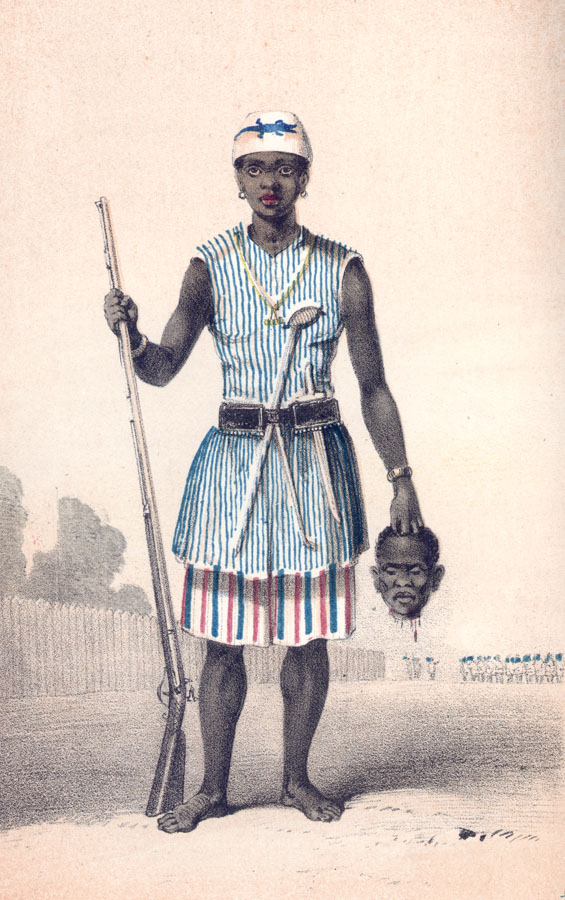
Más sobre Mino (Benin)
31: Bangala (DR Congo)
In the centuries before European colonists arrived, the Bangala people's animist beliefs were carried byshamans would dress in women's clothing in order the gain the ability to solve crimes such as murder.
Más sobre Bangala (DR Congo)
32: Mamluk (Egypt)
Más sobre Mamluk (Egypt)
33: Metis (Nepal)

Más sobre Metis (Nepal)
34: Acault (Myanmar)

Más sobre Acault (Myanmar)

